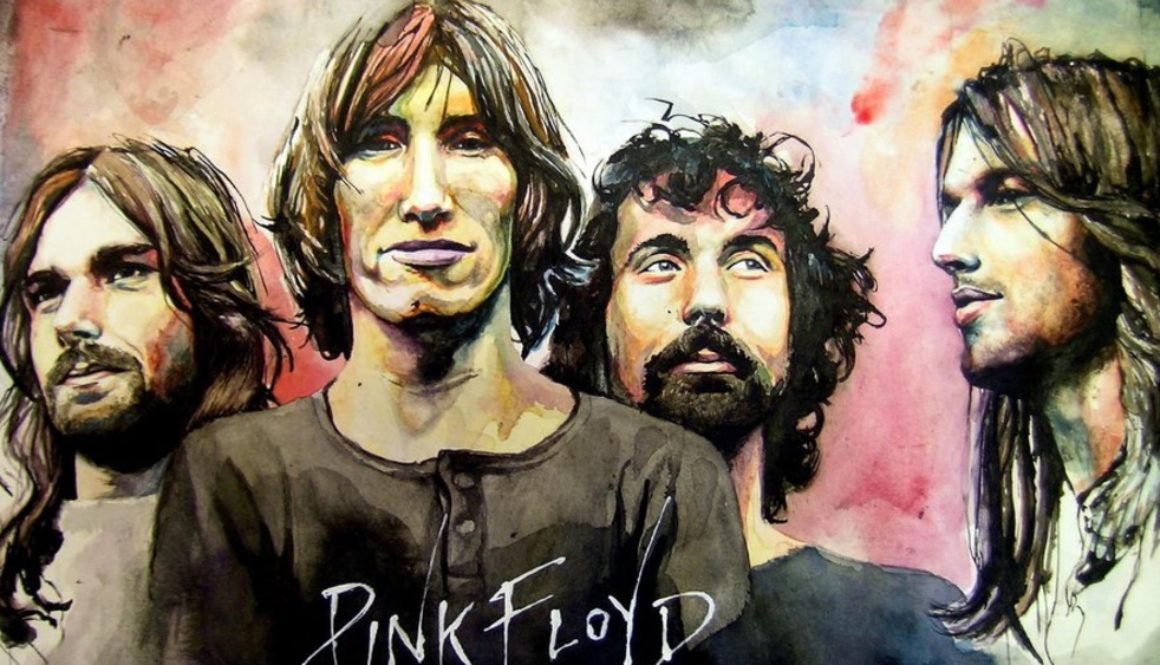Pink Floyd – Music Biography

When I was a kid I really wanted to know what Pink Floyd sounded like. Everyone I saw wearing a Pink Floyd shirt was a freaky looking dude with long hair. I guessed Pink Floyd must be the heaviest and loudest band in the world. When I started my journey into Floyd music with the The Wall, I was straisurprised that it isn’t loud at all. In fact, I needed to put on headphones and listen carefully to try and work out what all the odd little sounds in the distance meant. It was different than any kind of music I’d heard before, or since. So I bought Delicate Sound of Thunder next, figuring that another double album was the way to go. This live album introduced me to songs from the next two albums I would get: Dark Side of the Moon and Wish You Were Here.
Where Did Pink Floyd Come From?
Pink Floyd formed in London in 1965 when Syd Barrett moved there from Cambridge. He joined fellow musicians Nick Mason, Roger Waters and Rick Wright and their first album, The Piper at the Gates of Dawn, was released in 1967. It reached No.6 in the UK charts. Due to increasingly erratic behavior, Barrett would only remain with the band for another year. He was replaced by guitarist David Gilmour in 1968. The band spent the next few years recording film scores and albums that sounded more like psychedelic experiments. The group came into their own with the stronger emphasis songwriting and large themes on Dark Side of the Moon in 1973. It was the band’s first big commercial success, and they followed it with Wish You Were Here in 1975 and The Wall in 1979.
During these years bassist Roger Waters exerted more creative control over the band. While each member of Pink Floyd can be found with songwriting credits on Dark Side of the Moon (Mason has a credit on “Time”) and Wright has numerous contributions on Wish You Were Here, Waters is the principle songwriter on The Wall, although you will find Gilmour collaborated on the music of Young Lust, Run Like Hell, and Comfortably Numb. This phase culminated with Waters being the sole credited songwriter credit on the 1983 album The Final Cut, which proved to his last record with the band.
After a lengthy legal dispute concerning the use of the band’s name, Pink Floyd returned with David Gilmour at the helm, releasing two albums and touring successfully in the 80s and 90s. Aside from a brief reunion at Live 8 in 2005, most fans assumed that 1994’s The Division Bell would be the last collaboration for Pink Floyd. Syd Barret died in in 2006 and keyboardist Rick Wright died in September 2008. So it was quite a surprise in 2014, when Pink Floyd released one more album, The Endless River. Culled from 20 hours of outtakes from The Division Bell sessions, the album went straight to the top of the UK charts. David Gilmour has often credited Wright for having a huge influence on the Pink Floyd sound and The Endless River is partly a tribute to him. In spite of the fighting that went on in the band, their music has a magic to it that’s bigger than the personalities, lyrics and guitar solos. The band members know it, too. The closing track is “Louder Than Words,” and the lyrics begin: “We bitch and we fight, diss each other on sight, The sum of our parts, the beat of our hearts, is louder than words.”
Pink Floyd for Guitar
David Gilmour’s distinctive guitar style is often regarded as the most familiar aspect of the Pink Floyd sound. It’s instantly recognizable for its economy and tone and his gift of melodic phrasing is still influencing guitarists all over the world.
Guitar Noise has several Pink Floyd guitar lessons. For the solo acoustic guitarist there is a two part lesson on Wish You Were Here. The first part of Wish You Were Here gives beginners a step by step lesson on getting the strumming pattern to sound natural.
Part two picks up where the first part leaves off. It’s aimed more at intermediate players and shows you how to deal with with the intro solo. The solo at the beginning of Wish You Were Here uses four basic guitar techniques you should know: hammer-ons, pull-offs, slides and bends.
More ambitious students might like to look at Wish You Were Here arranged for two guitars in the lesson Applied Science. While actually a lot simpler than it sounds, this lesson covers alternate tuning, alternate chord voicings and basic leads and fills.
Absolute beginner might want to take a stab at Brain Damage / Eclipse from Dark Side of the Moon. This lesson takes very basic chords and adds a very simple strumming and picking pattern.
Those interested in alternate tunings and a challenge should take a look at the lesson Cover Story. This lesson looks at how to use alternate tunings as a tool for arranging imaginative versions of people’s songs and coming up with wild interpretations of old familiar tunes. Included is a solo acoustic version of the Pink Floyd song Take It Back.
Students of the bass guitar will want to try out Money – Bass Guitar Lesson. Learning how to play this classic Pink Floyd song is as easy as counting to seven (and occasionally eight)!
Comfortably Numb is one of the highlights from The Wall and we have arranged it for a single guitar, using many strumming and crosspicking, techniques we’ve gone over in our podcasts. If you’re going to play an emotionally charged song like this, you can’t hide behind a single strumming pattern. We’ll show you how to make a great sounding version for one guitar.
